Now of course any real person has at least a little of all 5 colors, what color you are or a character is, is question of what color they are the MOST. Because of this you can also talk about a person in terms of multiple colors, listing the colors they have the most in order. Their is more logic to this, but for the most part this post will stick to mono-colors. The Essential Nature of Each Color, as well as their relationships was first codified in the classical MTG Color Wheel:

Confused at parts? This is common and there has been much contention over the internet on what various parts MEAN. The colors were even more strictly defined by Mark Rosewater (the person in charge of keeping these things consistent) here:
http://markrosewater.tumblr.com/post/113185405628/i-know-that-each-color-has-a-little-phrase-like
"White - Peace through Structure
Blue - Perfection through Knowledge
Black - Power through Opportunity
Red - Freedom through Action
Green - Acceptance through Wisdom"
I want to explain more about each color, explaining how these ideas come through via the Colors' Characteristic and Iconic Creature.
A Characteristic Creature is a species of creatures not too much stronger then humans if at all, that appear in large numbers, that represent each of the Keywords of the colors at a mundane level, as a basic reality.
An Iconic Creature, is a Large Powerful Creature that represents the same keywords on a cosmological level, that represents those colors as ideals or as ontological forces.
These creatures both must be something easily recognizable to people even outside Magic: The Gathering meaning no species created for the card game especially (So no Leonin or Veldalken).
White:

Goal:
The goal of White is peace. White sees conflict as being the cause of all problems and so seeks to unite people and bring peace to all people.
Means:
The means of White is structure. White sees that the way to get peace is to end actions that would cause conflict. Discipline, Etiquette, Laws, these are the forces of white meant to restrict actions. White sees no problem with this because restricting "bad actions" is no bad thing, and an action which starts conflict is intrinsically a bad action, while an action that stops conflict is intrinsically a good action.
White's Strength is it's endurance. White's iron structure means it's very hard to disrupt, giving White control. White is disciplined and White is organized.
White's Weakness is it's stubborn uncreativity. There is a "right" way to do things and a "wrong" way to do things. You can't do things the "wrong" way. White will continue to follow protocol and rules even if to it's own detriment.
Keywords:
White's structure takes two forms primarily. If it tends towards Green and Red it will appear as Morality. If it tends towards Blue and Black it will appear as Order.
Morality:
White's Structure can take the form of Morality. This Keyword implies an objective sense of "right" and "wrong". It generally involves a sense of altruism and/or an obligation to serve the community. This structures people by guiding them towards actions that are "Moral" or collectively/socially focused and away from self-serving actions seen as egotistical and "Immoral". This brings about Peace by declaring conflict as an anti-altruistic action meant to hurt others, an action that is "immoral" and is to be avoided.
Morality-Characteristic: The Kithkin

At first glance the Kithkin break the rule that they have to be not made for MTG and recognizable to someone outside of MTG. However Kithkin are essentially the same race as a race that IS recognized by people outside MTG. They are the Halflings of D&D, the Hobbits of Lord of the Rings, the "Wee Folk" of the original Celtic and later Irish Legends.
The Kithkin are a physically weak race, due to their small stature, which fits in with White's Moralistic belief that we should protect the weak. Their strength is their social cohesion. They live in holes and hills in the plains (Plains are White's lands). Their society is unified by their good humor and their extremely common parties held for one another and gifts given to each other. This shows the idea of Morality as a practical mundane level, a society of weak people who live together, support each other, and live in a society that practices common and socially reinforced acts of altruism. Indeed the Hobbits the Kithkin were based on actually gave away gifts on their birthdays rather then received them. They enjoy a simple life of farming, eating, and socializing in their friendly communes, though are capable of greater courage then any of the big folk if the need to protect their friends or home arises. They are the perfect example of White's Morality as a characteristic race.
Morality-Iconic: Angels
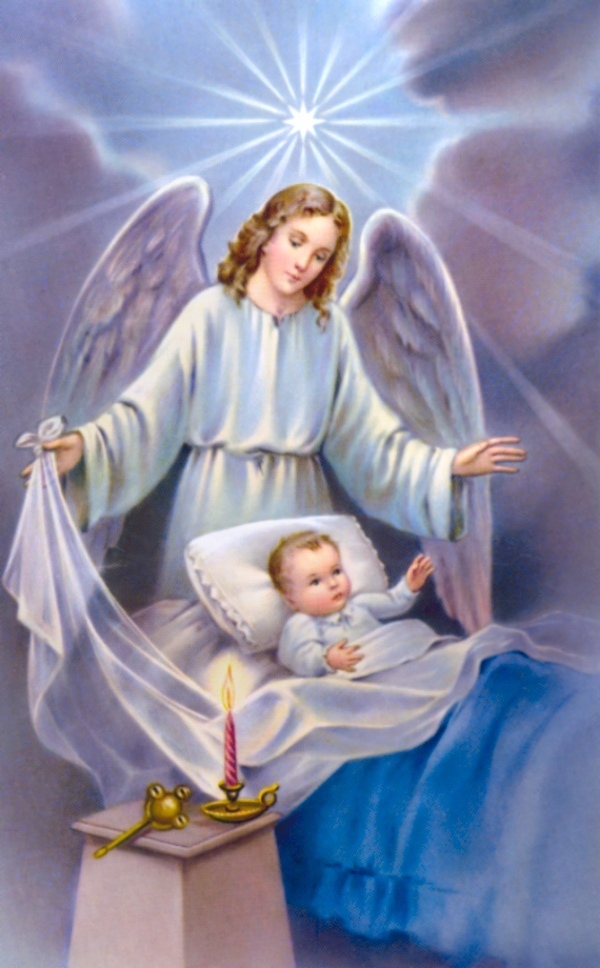
Angels are generally understood to be expressions of perfect morality. Across Media back to their beginnings in the Holy Books of the Abrahamic Faiths, the Angels acted as the arbiters of perfect harmony from the Perfectly Moral God. They Smote the Wicked and protected the weak and innocent, often depicted as being especially protective of the child, innocent and defenseless.
Order:
White's structure can also take the form of Order, which is civic laws, the laws of society. White believes that a society should have rules governing what a citizen can and can't do, so that the citizenry acts in a way good for the society as a whole. White believes that just as we have a duty to our fellows humans (Morality) or in MTG other species, so too do we have a duty to country.
Order-Characteristic: Dwarves

Dwarves are a short stocky race of people that live underground. They are known for their long memories, amazing forging abilities, love of gold and ale, and their extreme notions of duty.
It is in that last trait that Dwarves are the characteristic of Order. Even the most gold-hungry Dwarf would give it all up for King and Clan. Dwarves are known for their devotion to their duties toward their King/Nation, Clan/Family Members, and so forth. They live the reality of Order. Their Domain is the Great Earth itself, and it's deep never-ending structure of tunnels. They navigate these tunnels with metaphorically speaking, skin made of iron and bones of steel.
In addition, their is other traits of them suggesting their connection with Order. In particular Dwarves are known for their oaths, more unbreakable even their bodies. They possess incredible willpower due their rough discipline (which is a form of Order). Also a central part of Dwarf lore is generally that they fight all kinds of horrible giant monsters underground. While not as fragile as other wee folk, Dwarves must constantly be the underdog in fights against powerful monsters, winning through discipline, teamwork, and tactics, all white tools of the trade.
Order Iconic: Griffons

Might be surprising if you are unfamiliar with Griffon lore. Griffons were originally the Noble Guardian of the Heavens. They would fly from Heaven to herald the arrival of the True King or even to aid a legitimate king's claim to the throne.
Even more accordingly, Griffons as a social creature were known to follow elaborate plans to engineer the rise of power of the rightful King, showing their duty and commitment towards the idea of Proper Order. They are the Perfect Heralds of Pure Order.
Blue:

Goal:
The goal of Blue is "Perfection". This is a very vague goal but in general Blue sees the world as an entirely unoptimized place. Everything is systems and those systems are inefficient. Blue wants to make things run as efficiently as possible, and achieve a "perfect" Utopian Society of Progress. This might sound excessively idealistic to most, but Blue has much faith in possibility, and the future.
Means:
The means of Blue is "Knowledge". Blue believes the key to making your dreams come true, to optimizing your environment is to know how. Blue wants to learn as much information as it can so it can optimize the systems of the world as best as possible.
Blue's strength is in it's logical reasoning. Blue is very good at rationalizing a solution to a problem, logically solving puzzles.
Blue's weakness is in it's inactivity. Blue would rather learn every single factoid related to a problem and learn every possible angle to approach a problem then trying it and when confronted with a sudden problem may be struck by information paralysis.
Keywords:
Blue's Knowledge gathering takes two forms. If it tends towards White and Green it will appear as Logic. If it tends towards Black and Red it will appear as Artifice. Interestingly these things roughly correspond to the two ways of gaining knowledge; Rationalism and Empiricism respectively.
Logic:
Logic, or the theory of Rationalism, is the understanding of the world via applying logical principles to gain new information from currently possessed information. This forms the Basics of "Logical" thinking which Blue thinks very highly of, that one can deduce new information and like a detective can use the information one currently knows to come to conclusions and gaining more information. These logical principles such as A=A or A does not = not-A, if understood by all people can allow people to optimize their thinking and thusly their local systems.
Logic Characteristic: Merfolk

Merfolk are half fish humanoids that reside under the waves. It is very cold under the waves and this species, especially in MTG, have been known to reflect this coldness in their temperament. As a long-lived race that is adjusted to the gentle patterns of the ocean they act and think somewhat slowly most of the time, fully considering all options; the danger and coldness of the deep underwater somewhat dulling their passions.
Despite this, Merfolk are well known for having one passion: learning! Merfolk are extremely curious in all depictions, constantly wanting to know more and more. This can be troublesome when they start stealing human possessions, or entire humans, and dragging them below to see what they are. But most depictions of mermaid and human interactions is of a mutual learning experience, both sides having their curiosities and rational minds expanded from the encounter in a way Blue would smile at as grand progress.
Logic-Iconic: Djinn

Blue's Iconic is technically Sphinxes. And I get why, Sphinxes pose logic problems to travelers and if they lose it eats them. That makes for a great Iconic.....I guess?
Djinn really should be it though, and here's why. Djinn similarly logical problems to those who come under their possession. Specifically Djinn punishes those who act on impulse or intuitions (Red or Green). To deal with the Djinn properly requires a cool logical head.
Beyond this the Djinn are generally masters of deception, tricking people by using exact wordings instead of what they MEANT. Sometimes the Djinn doesn't even mean to trick them, it's merely that the words mean different things to each person. This again shows Blue's ideal of mutual learning.
Djinn also act a perfect Blue fantasy as well for another reason. If you can rationally conquer them they will give you wishes. You can optimize the world, you could finally perfect it, if only you know how....how much more blue can you get.
Artifice:
Blue is an experimenter, who wants to learn through direct observation as well. Blue wants to investigate, observe, see the information. This leads Blue to Innovation and Technology as Blue sees uses for things that others didn't consider.
This is part of Blue's Philosophy of Tabula Rasa, things are born a blank slate. If you don't consider something just as what it is, you can find whole new uses for it. If you don't look at a stick and think of it just a stick you might realize you can cause enough friction by rubbing it with another stick to get fire! If you educate people properly, they can overcome any innate part. Given proper information and grooming anyone can reform! You can build upon the world a better world if only you don't accept that things must be how they are.
Artifice Characteristic-Homunculus:

Homunculus are cousins of the Golems, and a predecessor of the Computer and the Robot. A Medevil idea, the notion was that you could pour an elixir of life into a metallic body and give it a simple command, which it would then follow. So long as your command was well thought-out, they had the potential to uplift all humanity. If the command was wrong however...
Constructs perfectly serve as the Characteristic of Artifice. They speak to Blue's ambition. They are new life, artificial and technological, designed to perfect the world in a particular way. Most importantly they are whatever you teach it. They are perfect Tabula Rasa, following the exact command given to them. And if they turn against you, it's only because you gave a bad command.
Artifice Iconic-Kraken:

Deep underneath the water lie the secret masters of the world. The original idea of the Kraken was a monsterous deep sea creature whose actions caused the natural disasters we see all around us, from tsunamis to hurricanes. In modern times this has gone even further with the idea of Krakens being psychic creatures who secretly control the minds of people (Ia Kraken fhthagn)
Kraken symbolically are the forces we don't understand. They are the ones who secretly shape the world to their wills, representing Blue's desire to engineer a perfect world. They represent the hidden element Blue is always searching for. The Mystery. Likewise Their actions are suggestive that it is not innate powers that control the world but living beings who have shaped it to their image again asserting Blue's Tabula Rasa and Nurture>Nature.
Black:

Goal:
The goal of Black is "Power." Black wants to accrue personal power for itself. Whether this is Physical Power, Political Power (Government Control), Economic Power (Money), etc. Black sees the world as a dog-eat-dog world where the strong survives. And Black knows it is going to be one of those survivors.
Means:
The means of Black is "Opportunity." Black is always eager to jump when a chance for power arises. Black will do things others would find distasteful, heinous, or profane. This is because Black sees a reality where nothing truly is these things, these are arbitrary constructs made. And Black is not gonna let any arbitrary construct bind it, Black serves itself and no other.
Black's biggest strength is it's resourcefulness. It will find a way out of impossible problems, if only because it's willing to do what no one else is willing to do, in order to survive.
Black's biggest weakness is it's paranoia. It has difficulty working with others because it assumes that everyone is out to get everyone else, and that at any moment a so called "friend" might stab you in the back for their own opportunity.
Keywords:
Black's Opportunity takes two forms. If it leans towards Blue and White, it appears as Parasitism. If it leans towards Red and Green, it appears as Amorality.
Parasitism:
Black knows that there is always winners and losers. The strong take from the weak. But that doesn't mean there is only one kind of strength. Stealth is a power. Wit is a power. Good Plans are a power. If you can steal victory from someone right from their nose, sucks to be them. The most dangerous animal is not the powerful bear or the vicious lion. It is the sneaky fly with it's diseases. Black knows that the key to getting what you want is to take power from those who have any amount of it to take. Dare to Rise above your ranks. Show Ambition and let no one keep you from your own goals.
Parasitism Characteristic-Vampires:

Vampires are a good characteristic for Parasitism for a very clear obvious reason. They drain the blood of others to become stronger and moreover to live. They are the Humanoid Parasite.
Beyond this Vampires are often shown turning the ones they have fed on into their minions, expressing their dominance and control over them. Vampires will show their dominance over normal humans as well, often tricking them into their control so they can feed on them. This has been a number of ways. Gold, Sex, Promises of Power, Hostages, Hypnosis. There is no wrong way to achieve the blood. What matters is the end result. Blood. Feeding. Power. Survival.
Vampires are also often shown to compete with equal status vampire for their blood reinforcing Black's belief that the world is one where winner takes all and losers die.
Parasitism Iconic-Horrors

Horrors are living embodiment of anti-reality. They are fears and darkness incarnate. As alien to us as can possible be. In Olden Times they were called Nightmares. They are creatures that tear up reality, feed on our fear.
It's said to be possible that a human who completes the right rituals and makes the right sacrifices can themselves come a Horror. But only the most ambitious and cold-blooded amoral person would even consider such an act....
Who knows. Maybe that's how they began.
Amorality:
Black believes that there is no objective good or evil. That if it can do something that benefits it, then it should. Black will says it's not pleasant, but it's reality and the other colors re just lying to themselves, trying to pretend reality is any better then it really is. Because Black thinks the world is a totally amoral place, that means that anyone who claims restrictions apply to them are externally putting an arbitrary limit on Black, which Black will not accept.
Amorality Characteristic-Zombies

Zombies in fiction are generally not a particularly moral bunch. They have no concept of "right" and "wrong". They have no concept of Civilization and it's rules. They represent the ending of those very things. They act together only as a matter of convenience, they tear up other species purely for their own survival. They are totally without any moral guilt or reprehension. They are single-minded in their goal. They are the hunger without end, the amoral race for survival.
Of course the true horror of Zombies is that they confirm an amoral universe. In most Zombie stories there is always the moment when the humans start turning on each trying to survive, confirming Black's belief that we are deeply amoral covering it up, ringing true to Black's paranoia. There is also that archetype of the human who gets bitten but doesn't mention it because they don't want to die and then turns on and consumes their former friends. Amorality indeed. To try and be moral in a Zombie story, to not attack them and live in peace, is to die a horrible death. Better start fighting for survival says the other colors while Black says it's done that the whole time.
Amorality Iconic-Demons

Demons are generally said to be Fallen Angels after rebelling a God who told them no. All though they vary, general traits of Demons in fiction and theology are beings who abide a lower Realm who do whatever they can to attain power. They almost always hate the thought of a Higher Power controlling them.
Demons represent Amorality put as a Cosmological Force. They are beings who make deals with mortals for power and invariably cheat in some way. They battle each other, unwilling to share power. They are the Universe's Chaotic Unfeeling Nature personified. They are temptations. They are the desecration of the holy, the sacred turned profane. You can't trust them to do anything, except fight for themselves.
Red:
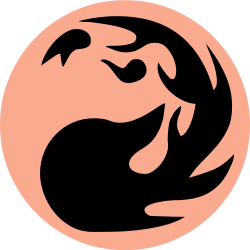
Goal:
The goal of Red is Freedom. Red wants to not be bound by rules and restraints, and wants to follow it's emotions. It believes everyone should have freedom, although generally cares about it's own freedom the most.
Mean:
The mean of Red is Action. Red believes that the worst thing you can do when faced with a problem is over-think it, Red tries to be in the moment and be flexible. Planning a solution too much will lock you in and not allow you to adapt to a problem as it's going on.
Red's greatest strength is it's spontaneity. Red lives in the here and now. Red goes with the flow. Red will seize the moment at every possible moment. This gives it an ability to change and adapt to whatever life may throw at it.
Red's greatest weakness is it's short-sightedness. Red doesn't plan beyond the immediate and so will often find itself suddenly in a problem and wonder how it got there.
Keywords:
Red's Action can take two forms. If it leans towards Black and Blue, the action appears as Chaos. If it leans towards Green and White, the action appears as Impulse.
Chaos:
Red believes the world is inherently chaotic. Trying to control the world is only going to leave you more frustrated and unable to control anything. "The tighter you clench your fist, the most star systems slip through your fingers.". Red believes that Chaos is not a bad thing either, as it allows for change and progress. Red has clear faith that in Chaos people will act in a free way, unhindered by rules and regulations, which Red sees as implicitly good.
Chaos Characteristic-Goblins:
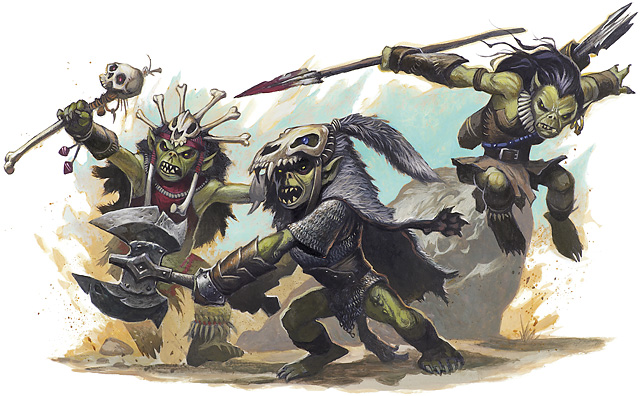
While the specific change from depiction to depiction, Goblins originally were and still generally are a race of mischievous mountain-dwelling creatures that love to party and have fun, and wish the mean bigger races didn't keep stopping their fun just because it involved "Some explosions" or "Throwing Little Timmy off a mountain."
While some depictions are much more Black, generally Goblins are a very red-based race well suited for Chaos' Characteristic. They are spontaneous and ever-changing, impossible to predict, and love to spread a little confusion and chaos.
Chaos Iconic-Dragons:
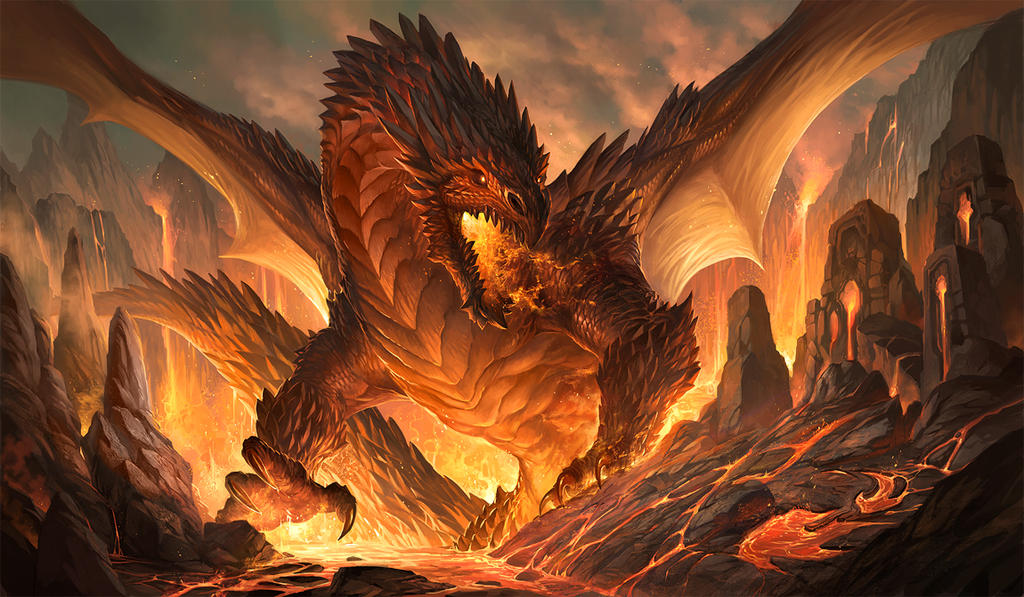
The Dragon is a truely epic beast and the kind of wherever he is, usually some high place where it's chosen to make it's residence.
Dragons were long the symbol of Chaos. They destroyed whole kingdoms and kidnapped royalty like Princesses. When they were sentient they were often concerned for their own happiness and not much else. That said they certainly weren't always even and sometimes appeared to signal the end of an Corrupt Empire.
Dragons also work as Chaos' Iconic because they resist all logical and civilized forms of control. Magic doesn't work on them. They defy the laws of physics. They laugh at armies.
Impulse:
Red thinks we should trust our own emotions more often. Just like we can't others limit us, we can't let ourselves limit us. You are your own worst enemy, harshest critic, and all other forms of opposition.
Impulse-Characteristic: Viashino

The Viashino is MTG's name for Lizardfolk, the bog-dwelling dinosaur people.
To succeed in the hunt, the Viashino must remain entirely in the moment, leaping at the exact right moment and pursuing and tearing before the prey can get away. They must act entirely on impulse, no room for reservations or thought.
Likewise Viashino culture emphasizes therefore emotional thought, acting with a psuedo-collective subconscious, by relying in emotional wavelengths.
Impulse Iconic-Titans:

In Greek Mythology the Titans were primordial beings representing powerful forces which ruled humanity. They were the children of Mother Earth (Gaia) and Father Sky (Ouranus). They were ruled entirely by emotion seemingly, acting based on fear, hope, and desire.
More importantly as Impulse's Iconic, Titans are beings without any self-restraints acting entirely on their role as the force of X. From Chronos, Time, to Hyperion, Light, to Prometheus and Epimetheus, Forethought and Afterthought. None could control them, even themselves.
Prometheus even went against Zeus, the lord of Olympus, refusing to bow to his whim because he wanted to grant humanity fire and civilization.
Green:

Goal: Acceptance
The goal of Green is acceptance. Green believes that the world is what it is and that the cause of suffering and pain is trying to struggle against the way of the world.
Means: Wisdom
The means of Green is wisdom. Green wants to grow it's understanding of itself and the world around it, so that it understands the roles of both and thus can understand and accept of the world.
Green's greatest strength is it's genuine-ness. Green wants simple things, and enjoys a calm simple lifestyle. This means that Green can live in tranquility with almost any environment, adapting itself to suit it's surroundings.
Green's greatest weakness is it's naivety. Green expects people to act simply and honestly, Green expects the world to be benevolent and if something bad happens to you, well it was probably meant to happen. Green has difficulty feeling any strong sense of agency.
Keywords:
Green's Wisdom takes two forms. When it leans towards Red and Black it appears as Instinct. When it leans towards White and Blue it appears as Interdependence.
Instinct:
Green feels we have grown too far apart from ourselves. It feels that if we could listen to our deep instincts we'd know what we really need and would no longer feel the pressure of having to live up to some standard we've set for ourselves that will never make up happy.
Instinct Characteristic-Beasts
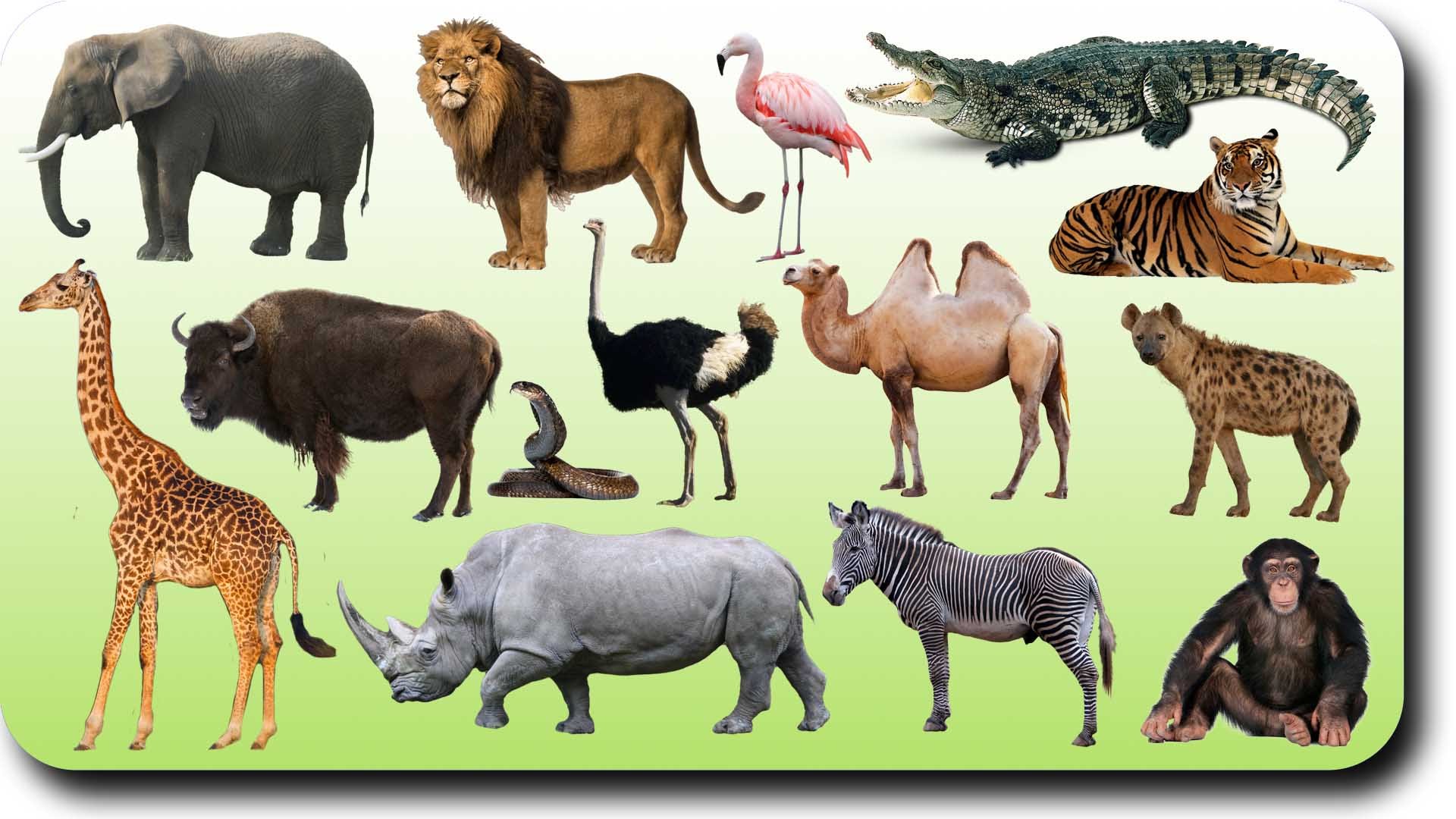
MTG treats this as a single type and taken together it really does make sense as Instinct's Characteristic. Green thinks that animals live lives of dignity, not disrupting their environment and simply being who they are without feeling like they must disrupt the whole web of life to become something else.
Instinct Iconic-Hydras:

The Hydra is nature's most perfect predator. Indeed it some ways it represent's nature's true power. Head after Head that feeds on all things nearby. Regeneration keeping it endless coming back stronger and stronger.
And that really is the essence of the Hydra. It simply is and grows stronger from that being. If harmed and fought it becomes stronger gaining new heads.
Despite it's incredible complexity, it is also a creature of incredible elegance much as how Green sees Nature.
Interdependence:
Green also feels we have grown too far apart from each other. We fight each other when this antithetical to our very nature. Green sees the world as a system of interdependent parts that all work together and support each other and trying to take advantage of each is only screwing us all over. Green believes people should work together by trying to fufill their natural roles which will create a natural and interdependent society.
Interdependence Characteristic-Elves:

Elves are the defenders of the woodlands and the natural order. They are a perfectly interdependent society, who are in harmony with each other and their surroundings. With their ancient arcane wisdom Elves know the role of all things and take it upon themselves to protect the natural order.
This does not mean the Elves will protect all life. Sometimes life becomes destructive and harmful to the order and that's when the Elves will spring to the fight. "One bone broken for every twig snapped beneath". They are the Soldiers of Destiny and the People of the Wilds.
Interdependence Iconic-Elementals:

Elementals are the forces of nature sprung to life. They act perfectly in accord with their role. Water Elementals wetten, Air Elementals Blow, Time Elementals Change, Life Elementals Live.
Yet despite this the elementals are in harmony with each other in most cases. Fire Elementals do not seek the destruction of the water elementals that kill them. Likewise Wood Elementals don't see the death of fire elementals that burn them. Elementals even when they destroy each other exist in a harmony with each other that us mortal beings can not understand.
So those are the Characteristics and Iconics of Each Color's Keywords and how they suit them. Part 2 will be coming in a couple of days. I hope you enjoyed.
You know there are many blogs you can tell you had a lot of work put into it and this is definitely one of them, that was fantastic and interesting, great work Imp, the white is my favorite
ReplyDeleteFriendly Neighborhood Imp: Understanding The Mtg Colors Through Their Species >>>>> Download Now
ReplyDelete>>>>> Download Full
Friendly Neighborhood Imp: Understanding The Mtg Colors Through Their Species >>>>> Download LINK
>>>>> Download Now
Friendly Neighborhood Imp: Understanding The Mtg Colors Through Their Species >>>>> Download Full
>>>>> Download LINK Zs